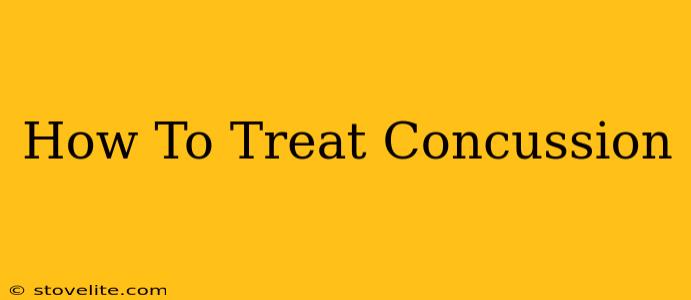A concussion, also known as a mild traumatic brain injury (mTBI), is a complex injury that requires careful management. Understanding how to treat a concussion is crucial for ensuring proper healing and preventing long-term complications. This guide provides a comprehensive overview of concussion treatment, emphasizing both immediate actions and long-term recovery strategies.
Understanding Concussion: The First Steps
Before diving into treatment, it's important to recognize the symptoms of a concussion. These can vary widely from person to person, but common signs include:
- Headache: Often described as a throbbing or persistent pain.
- Dizziness: A feeling of lightheadedness or imbalance.
- Nausea and Vomiting: These symptoms are frequently associated with concussion.
- Sensitivity to Light and Sound: Bright lights and loud noises can exacerbate symptoms.
- Confusion and Disorientation: Difficulty concentrating or remembering events.
- Memory Problems: Trouble recalling recent events or conversations.
- Sleep Disturbances: Insomnia or excessive sleepiness.
- Mood Changes: Irritability, anxiety, or depression.
- Balance Problems: Difficulty with coordination and gait.
What to do immediately after a suspected concussion:
- Seek Medical Attention: It's crucial to consult a doctor or other healthcare professional immediately after a head injury, even if symptoms seem mild. A proper diagnosis is essential.
- Rest: Avoid physical activity and mental exertion. This includes screen time (phones, computers, TV).
- Monitor Symptoms: Keep a close watch on the individual's condition and note any changes in symptoms.
Concussion Treatment: A Multifaceted Approach
Concussion treatment is not a one-size-fits-all approach. The best course of action depends on the severity of the injury and the individual's response to treatment. However, several key elements generally form the basis of a successful recovery:
1. Physical Rest and Gradual Return to Activity
Cognitive Rest: This means limiting activities that require mental effort, such as reading, studying, or using electronics.
Physical Rest: Avoid strenuous physical activity until cleared by a medical professional. This is crucial to allow the brain to heal.
Gradual Return to Activity: A stepwise approach to increasing physical and mental activity is vital. This is often guided by healthcare professionals using a graduated return-to-learn and return-to-play protocol. Pushing too hard too soon can worsen symptoms and prolong recovery.
2. Medical Management
A doctor may recommend certain medications to manage specific symptoms:
- Pain Relievers: Over-the-counter pain relievers like acetaminophen (Tylenol) can help manage headaches. Avoid ibuprofen (Advil, Motrin) and naproxen (Aleve) as they can increase bleeding risk.
- Antiemetics: These medications can help reduce nausea and vomiting.
3. Therapy
Depending on the severity and persistence of symptoms, various therapies may be beneficial:
- Physical Therapy: To address balance problems and improve coordination.
- Occupational Therapy: To assist with daily living tasks and improve cognitive function.
- Speech Therapy: If speech or communication difficulties arise.
- Neuropsychological Testing: This can help assess the extent of cognitive impairment and guide rehabilitation efforts.
Long-Term Recovery and Prevention
Complete recovery from a concussion can take weeks or even months. Patience and adherence to the treatment plan are essential. Regular follow-up with a healthcare professional is crucial to monitor progress and address any lingering symptoms.
Long-term effects, while rare, are possible and should be monitored:
- Post-concussion syndrome: Persistent symptoms that last beyond the expected recovery period.
- Chronic traumatic encephalopathy (CTE): A progressive degenerative brain disease associated with repeated head injuries.
Preventing Future Concussions:
- Wearing protective gear: Helmets are essential for participating in contact sports.
- Following safety guidelines: Adhering to safety protocols in sports and other activities.
- Addressing underlying conditions: Treating any pre-existing medical conditions that increase the risk of concussion.
Disclaimer: This information is intended for educational purposes only and should not be considered medical advice. Always consult with a qualified healthcare professional for diagnosis and treatment of a concussion. Early and appropriate medical intervention is critical for optimal recovery.

